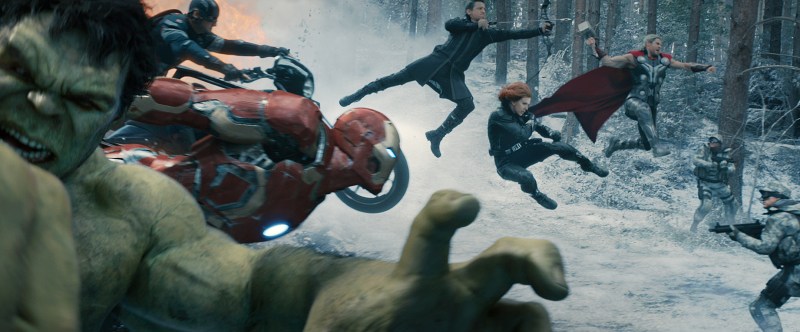It’s been a couple years since Earth’s mightiest heroes converged on New York to save the world and its mortal occupants in Marvel’s “The Avengers.” Since then, our beloved protectors of the globe have splintered, kicking butt in a series of underwhelming solo ventures (think “Iron Man 3,” “Thor: The Dark World”).
Now, with Joss Whedon’s “Avengers: Age of Ultron,” the band is finally back together, as Iron Man and company join forces once more to fight power-hungry robot and snarling baddie Ultron (James Spader). The stakes couldn’t be higher both for our intrepid heroes and for Whedon — who faces the formidable task of matching the global impact of “The Avengers.”
Regrettably, despite an impressive amount of showmanship, Whedon’s latest effort falls surprisingly flat, forever doomed to toil in the shadow of the first installment. Though arguably the most technically impressive Marvel feature to date, “Avengers of Age of Ultron” lacks the elusive spark that ultimately made the original such a rip-roaring good time.
With S.H.I.E.L.D. in shambles following the Hydra insurrection in “Captain America: The Winter Soldier,” the team lacks organizational oversight. Yet, when we first encounter the Avengers in action, they actually seem to be getting along quite well. Breaking into the castle of Baron von Strucker (of Hydra fame) in order to re-acquire Loki’s scepter, the crew is in fine form, throwing motorcycles and sassing each other as Whedon-ites are wont to do. As a matter of fact, everything is going groovy for the Avengers, at least until Tony Stark (Robert Downey Jr.) attempts to harness the scepter’s power to create the world’s first sentient machine.
To everyone’s chagrin, Stark is successful and his pet project doesn’t exactly take kindly to Iron Man and the rest of the gang. Designed to bring peace to the world, Stark’s baby evolves into Ultron, a mean-spirited robot convinced that the only way to bring peace to Earth is to destroy every last human being (naturally). After wreaking all sorts of havoc, Ultron escapes from Stark’s lab, disappears into the night, and recruits two “enhanced” siblings, Wanda (Elizabeth Olsen) and Pietro Maximoff (Aaron Taylor-Johnson) to do his evil bidding. In turn, forced to confront their worst fears, the Avengers struggle to work together and stop Ultron before he brings about humanity’s untimely demise.
And that’s just scratching the surface.
“Avengers: Age of Ultron” boasts an absurd amount of backstory. Hydra, S.H.I.E.L.D., Loki’s scepter, Asgard, Jane Foster, the Battle of New York, Nick Fury, Peggy Carter, vibranium: Embedded beneath the film’s glossy veneer is a laundry list of things you need to know to even begin to understand what’s taking place onscreen. Not surprisingly, the latest installment in the Marvel franchise is also exploding with exposition: Ultron doesn’t make an appearance for a solid thirty minutes, and when he eventually does, his intentions don’t become clear until thirty minutes prior to the grand finale. Put simply, like so many doomed fantasy flicks, the latest entry in the MCU (Marvel Cinematic Universe) is effectively undercut by a preponderance of plot, be it previously established or newly introduced. Even for someone who has seen every Marvel tent-pole, it’s exhausting work trying to keep up and, most devastatingly, it’s not all that rewarding.
“Age of Ultron” is weird little film: not the first, not the last, but the unfortunate middle installment, weighed down by exposition and deflated by unfulfilled promises.
In “Avengers: Age of Ultron,” Whedon constantly feels like he’s setting up a story that never quite comes to fruition. Two villains make their showy debuts in the film’s swift two-hour run time: One the future big bad of Marvel’s “Black Panther,” the other the proposed antagonist for “Avengers: Infinity War.” We also get three new superheroes: Scarlet Witch, Quicksilver and the Vision. Whedon even takes the time to introduce two entirely fictitious countries: Sokovia, the birthplace of the twins, and Wakanda, home to T’Challa, known by comics fans as Black Panther. Every last element of “Avengers: Age of Ultron” is gawky preparation for future properties, and the corresponding lack of closure is incredibly disheartening.
Regardless, despite the film’s many narrative failings, “Age of Ultron” is definitely the most aesthetically realized film in Marvel’s canon. Packed with exceptionally choreographed long takes that dart, weave and fly their way through the action, “Age of Ultron” destroys the inherent distance between spectacle and spectator. Whedon also has a delightful grasp of deep staging, allowing the film’s drama to unfold on multiple planes of action and granting the many fight scenes a sense of scale and unity. Near the film’s conclusion, Whedon inserts a stellar slow-motion tracking shot that both renders all of the Avengers in the divine throes of taking names and casually flips the bird to naysayers who believe that all action sequences are somehow identical.
“Age of Ultron” also happens to be exceptionally well acted, assembling an ever-expanding ensemble of A-list performers who truly make the most with what they’re given. Olsen, a newbie to the MCU, is particularly captivating as the telekinetic Scarlet Witch. In her sparse exchanges with key characters (Ultron, Hawkeye), Olsen exudes a remarkable amount of anguish and ferocity. Olsen’s saucer-like eyes light up the screen, holding our attention in a film that asks us to focus on a billion things at once.
The returning cast also holds their own amid the orgy of special effects, with both Scarlett Johansson (Black Widow) and Jeremy Renner (Hawkeye) adding layer after layer to their previously underdeveloped characters. Some Avengers feel like they’re just phoning it in (i.e. Robert Downey Jr.), but, for the most part, the stars of “Age of Ultron” remain Marvel’s greatest assets.
Contact Will Ferrer wferrer ‘at’ stanford.edu.
